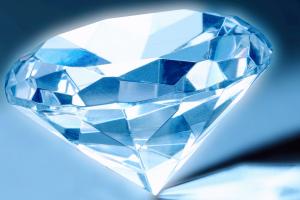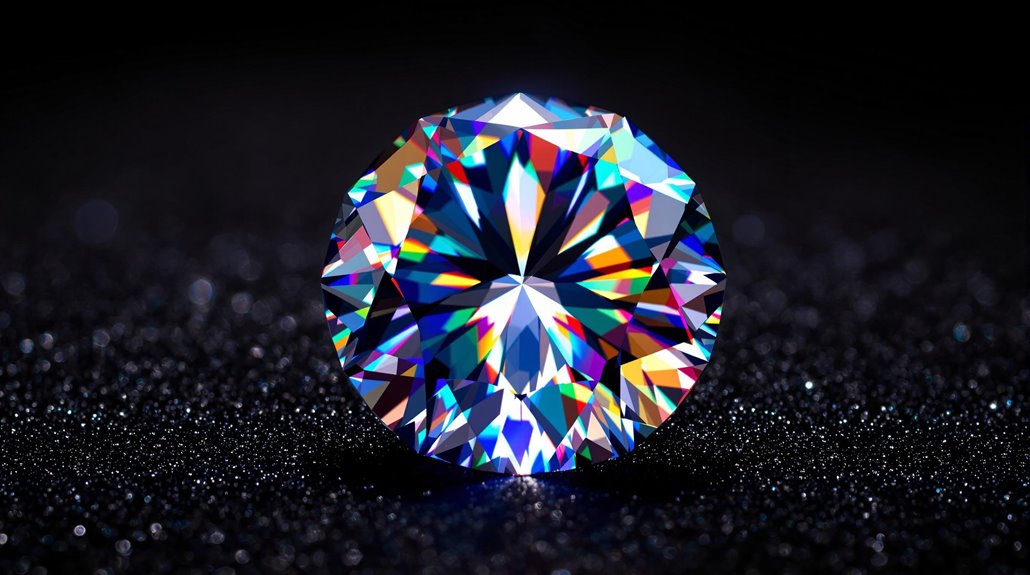Article Contents
- 1 Frequently Asked Questions
- 1.1 How Long Does It Take to Cut a Diamond to Ideal Proportions?
- 1.2 Can a Poorly Cut Diamond Be Recut to Improve Its Quality?
- 1.3 Does the Diamond's Color Affect How the Cut Appears?
- 1.4 Are Machine-Cut Diamonds Better Quality Than Hand-Cut Diamonds?
- 1.5 How Much Does Cut Quality Affect a Diamond's Resale Value?
Diamond cut quality represents the cornerstone of a jewel's brilliance, determined by precise angles, proportions, and expert craftsmanship. Master cutters transform rough stones through calculated faceting that optimizes light performance, creating the signature fire and sparkle that distinguish exceptional diamonds. The interplay between crown angles, table percentages, and symmetry culminates in grades from "Ideal" to "Poor," with the prestigious "Triple excellent" marking the pinnacle of cutting achievement. This intricate artistry reveals the hidden potential within each stone.
Brilliance, the defining characteristic of a diamond's attraction, finds its genesis in the art and science of diamond cutting. The intricate process of transforming rough diamonds into gleaming masterpieces requires a comprehension of precise angles, proportions, and symmetrical facets that collectively determine a stone's cut quality. Unlike common misconception, cut characteristics extend far beyond the shape of a diamond, encompassing the complex interplay of light with the stone's carefully crafted surfaces. Among the prestigious grading standards established by authorities like the GIA, cut quality emerges as the most significant factor in determining a diamond's overall beauty and value. A diamond's cut determines its sparkle and brilliance, making it the most crucial of all quality factors.
The mastery of diamond cutting reveals itself through the stone's interaction with light. A well-executed cut creates a mesmerizing display of brilliance, fire, and scintillation, whereas imperfect execution results in a lackluster appearance. The precision of proportions plays a pivotal role, as even slight variations in crown angles can substantially affect a diamond's performance. A shallow crown angle produces brilliance without fire, while a steep angle creates fire at the expense of brilliance, highlighting the delicate balance required in achieving perfection. The table percentage ratio is particularly crucial, as it directly influences how light enters and exits the diamond. Continuous research and data updates drive improvements in cutting techniques to maximize diamond performance.
The expedition to diamond superiority encompasses various cutting styles, each with its distinct characteristics. The brilliant cut, adorned with triangular and kite-shaped facets, creates an enchanting light display that has become the hallmark of fine diamonds. Step cuts, with their elegant trapezoidal facets running parallel to the girdle, showcase a diamond's inherent color and clarity. The round brilliant cut, featuring 57 to 58 precisely positioned facets, stands as the pinnacle of cutting achievement, maximizing light return and creating unparalleled sparkle. Cut grade scale remains the international standard for assessing a diamond's overall quality and value.
At the heart of diamond cut quality lies the artisan's dedication to symmetry and polish. These finishing details, often described as the final brushstrokes of a masterpiece, transform a well-cut diamond into an extraordinary jewel. The importance of craftsmanship becomes evident in the pursuit of the coveted "triple excellent" grade, where precision of cut, polish, and symmetry must meet the most stringent standards set by prestigious institutions like Tiffany & Co.
The assessment of cut quality follows a structured hierarchy, from the exceptional "Ideal" grade through "Excellent," "Very Good," "Good," "Fair," and "Poor." This systematic evaluation, conducted by respected certification bodies, provides confidence to those pursuing the finest diamonds.
The endeavor for perfect cut quality represents not just technical superiority, but the achievement of diamond cutting's ultimate goal: creating a stone that captures and returns light with maximum efficiency and beauty, resulting in a jewel that truly embodies the essence of luxury and refinement.
Frequently Asked Questions
How Long Does It Take to Cut a Diamond to Ideal Proportions?
Achieving ideal proportions through modern cutting techniques typically requires 4-8 hours for a one-carat diamond, though larger stones or complex cuts may extend several days or weeks.
Can a Poorly Cut Diamond Be Recut to Improve Its Quality?
Yes, diamond recutting alternatives can significantly elevate a poorly cut stone's quality. Professional diamond cut assessment determines if recutting will boost brilliance during maintaining sufficient carat weight.
Does the Diamond's Color Affect How the Cut Appears?
Although color affects overall perception, it's the interplay of color and light reflection that truly impacts cut appearance. Better color grades improve light performance, creating more lively brilliance and sparkle.
Are Machine-Cut Diamonds Better Quality Than Hand-Cut Diamonds?
Neither machine vs. hand cut diamonds are inherently superior. Modern diamond cutting techniques offer precision, whereas hand-cut stones provide unique character. Both methods can produce exceptional quality when expertly executed.
How Much Does Cut Quality Affect a Diamond's Resale Value?
Exact proportions and high-quality polish significantly influence resale value. Cut quality can impact a diamond's worth by 10-30%, with outstanding cuts maintaining stronger value because of superior brilliance and market demand.

